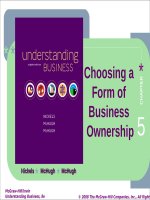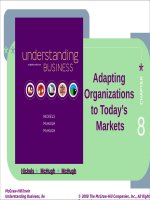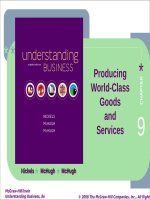Understanding business 11th by mchugh nickels chap011
Bạn đang xem bản rút gọn của tài liệu. Xem và tải ngay bản đầy đủ của tài liệu tại đây (5.3 MB, 71 trang )
CHAPTER 11
Human Resource
Management:
Finding and
Keeping the Best
Employees
McGraw-Hill/Irwin
Copyright © 2015 by the McGraw-Hill Companies, Inc. All rights reserved.
LEARNING OBJECTIVES
1. Explain the importance of human resource
management, and describe current issues in
managing human resources.
2. Illustrate the effects of legislation on human resource
management.
3. Summarize the five steps in human resource
planning.
4. Describe methods that companies use to recruit new
employees, and explain some of the issues that
make recruitment challenging.
11-2
LEARNING OBJECTIVES
5. Outline the six steps in selecting employees.
6. Illustrate employee training and development
methods.
7. Trace the six steps in appraising employee
performance.
8. Summarize the objectives of employee
compensation programs, and evaluate pay systems
and fringe benefits.
11-3
LEARNING OBJECTIVES
9. Demonstrate how managers use scheduling plans
to adapt to workers’ needs.
10. Describe how employees can move through a
company: promotion, reassignment, termination,
and retirement.
11-4
TONY HSIEH
Zappos
• Hsieh sold his first company to
Microsoft for $265 million,
before becoming Zappos’ CEO.
• Changed Zappos’ corporate
work environment so reps wow
customers.
• The work environment is kept
open and accessible.
11-5
NAME that COMPANY
This company manages its global workforce of
about 100,000 employees and 100,000
subcontractors with a database that matches
employee skills, experiences, schedules, and
references with jobs available.
Name that company!
11-6
HUMAN RESOURCE
MANAGEMENT
LO 111
• Human Resource Management (HRM) The
process of determining human resource needs and
then recruiting, selecting, developing, motivating,
evaluating, compensating and scheduling employees
to achieve organizational goals.
• HRM’s role has grown because of:
1. Increased recognition of employees as a
resource.
2. Changes in law that rewrote old workplace
practices.
11-7
HUMAN RESOURCE MANAGEMENT
LO 111
11-8
UNCOVERING the
SECRETS of HRM
LO 111
Things Your HR Manager Doesn’t Tell You
• We’re shortstaffed and under pressure too.
• We’re not always going to be able to help in the
way you hope.
• We can help you move up the career ladder.
• What you post on Facebook can get you fired.
Source: Smart Money, www.smartmoney.com, accessed November 2014.
11-9
DEVELOPING the FIRM’S
ULTIMATE RESOURCE
LO 111
• Service and hightech manufacturing requires
employees with highly technical job skills.
• Such workers are scarce,
making recruiting and
retention more important
and more difficult.
• The human resource job is
now the job of all managers
in an organization.
11-10
CHALLENGES in FINDING
HIGHLEVEL WORKERS
LO 111
• A shortage of trained workers in key areas
• Worker shortage in skilled trades
• An increasing number of baby boomers who
delay retirement
• A declining economy with fewer fulltime jobs
• Expanding global markets with lowwage
workers
• Increasing benefit demands and benefit costs
• A decreased sense of employee loyalty
11-11
CIVIL RIGHTS ACT of 1964
LO 112
• Title VII prohibits discrimination in hiring, firing,
compensation, apprenticeships, training, terms,
conditions or privileges of employment based on:
- Race
- Religion
- Creed
- Sex
- Age
- National Origin
11-12
1972 EQUAL EMPLOYMENT
OPPORTUNITY ACT (EEOA)
LO 112
• Strengthened the Equal Employment Opportunity
Commission (EEOC).
• Gave EEOC the right to issue workplace
guidelines for acceptable employer conduct.
• EEOC could mandate specific recordkeeping
procedures.
• EEOC was vested with the power of enforcement.
11-13
CONTROVERSIAL PROCEDURES
of the EEOC
LO 112
• Affirmative Action Policy designed to “right past
wrongs” by increasing opportunities for minorities and
women.
• Reverse Discrimination Discriminating against
members of a dominant or majority group (e.g. whites
or males) usually as a result of policies designed to
correct previous discrimination against minority or
disadvantaged groups.
• This policy has been at the center of many
debates and lawsuits.
11-14
CIVIL RIGHTS ACT of 1991
and OFCCP
LO 112
• Civil Rights Act of 1991
- Amended Title VII and gave victims of discrimination
the right to a jury trial and possible damages.
• Office of Federal Contract Compliance Programs
(OFCCP)
- Ensures that employers doing business with the
federal government comply with the
nondiscrimination and affirmative action laws.
11-15
LAWS PROTECTING
EMPLOYEES with DISABILITIES
LO 112
• Americans with Disabilities Act of 1990 (ADA)
- Requires employers to give applicants with physical or
mental disabilities the same consideration for employment as
people without disabilities.
- Passage in 2008 of Americans with
Disabilities Amendments Act
expanded protection.
- 2011 saw regulations that widen the
range of disabilities covered by the
ADA and shift the burden of proof of
disability from employees to
employers.
11-16
AGE DISCRIMINATION in
EMPLOYMENT ACT (ADEA)
LO 112
• Age Discrimination in Employment Act (ADEA)
- Protects workers 40 and
over from employment
and workplace
discrimination in hiring,
firing, promotion, layoff,
compensation, benefits,
job assignments and
training.
11-17
MINDING the LAW in HRM
LO 112
• Employers must know the law
and act accordingly.
• Legislation affects all areas of
HRM.
• Court cases highlight that
sometimes it’s proper to go
beyond providing equal rights.
• Changes in law and legislation
occur regularly.
11-18
TEST PREP
• What’s human resource management?
• What did Title VII of the Civil Rights Act of 1964
achieve?
• What’s the EEOC and what was the intention of
affirmative action?
• What does accommodations mean in the
Americans with Disabilities Act of 1990?
11-19
HUMAN RESOURCE PLANNING
PROCESS
LO 113
1) Preparing a human resource
inventory of employees.
2) Preparing a job analysis.
3) Assessing future human
resource demand.
4) Assessing future labor
supply.
5) Establishing a strategic plan.
11-20
WHAT’S a JOB ANALYSIS?
LO 113
• Job Analysis – A study of what employees do who
hold various job titles.
• Job Description – A summary of the objectives of
the job, the type of work, the responsibilities and
duties, working conditions and relationship to other
jobs.
• Job Specifications A summary of the minimum
qualifications needed to do a particular job.
11-21
RECRUITING EMPLOYEES
LO 114
• Recruitment The set of activities for obtaining the
right number of qualified people at the right time.
• Human resource managers use both internal and
external sources to recruit employees.
• Small businesses often make use of web
sources like CareerBuilder and Monster to
recruit employees.
11-22
COMPETING for the
CREAM of the CROP
• To survive, small businesses must recruit and
retain qualified workers.
• Unfortunately, they lack the resources of larger
companies to compete for employees.
• Small businesses need innovations like:
- Letting staff help recruit and select candidates.
- Audition an employee.
- Seek out publicity.
11-23
EMPLOYEE SOURCES
LO 114
11-24
SELECTION
LO 115
• Selection The process of
gathering information and
deciding who should be hired,
under legal guidelines, to
serve the best interest of the
individual and the
organization.
11-25









